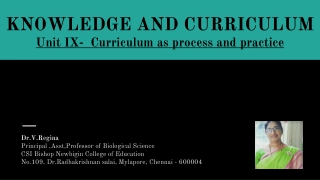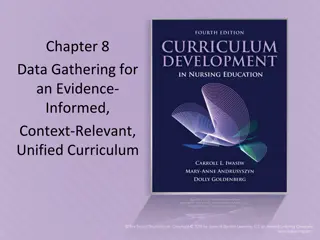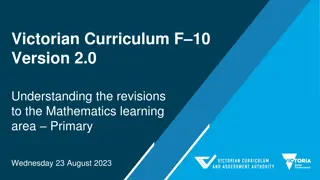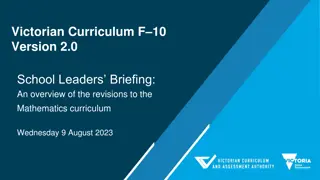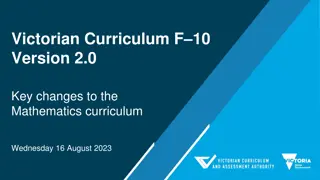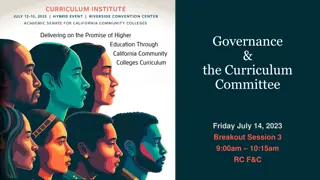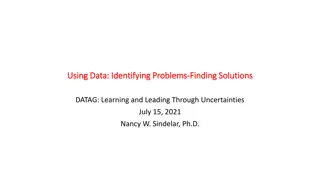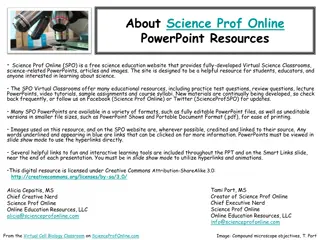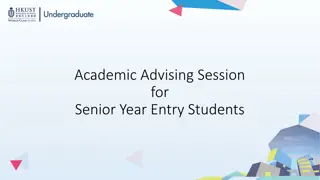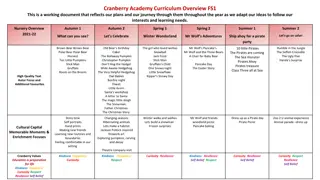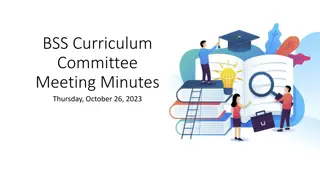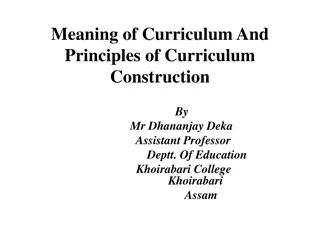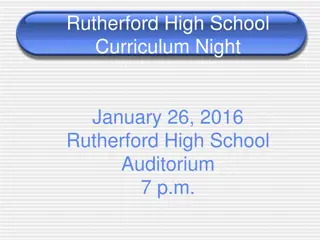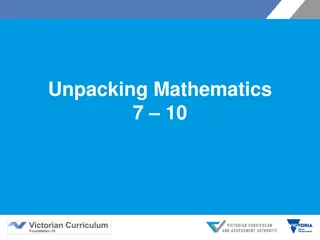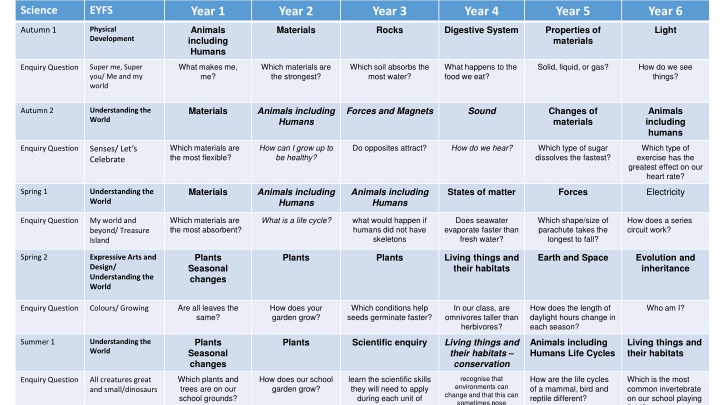
Exploring Science Curriculum for Early Years and Key Stage 1-3
Delve into a comprehensive science curriculum covering topics such as animals, materials, rocks, digestive system, light, physical development, and more for EYFS, Year 1-6. Engage in exciting enquiries and investigations to understand concepts like life cycles, properties of materials, the human body, forces, magnets, sound, and electricity. Nurture scientific skills, observation, and critical thinking with hands-on activities both in and out of the classroom.
Download Presentation

Please find below an Image/Link to download the presentation.
The content on the website is provided AS IS for your information and personal use only. It may not be sold, licensed, or shared on other websites without obtaining consent from the author. If you encounter any issues during the download, it is possible that the publisher has removed the file from their server.
You are allowed to download the files provided on this website for personal or commercial use, subject to the condition that they are used lawfully. All files are the property of their respective owners.
The content on the website is provided AS IS for your information and personal use only. It may not be sold, licensed, or shared on other websites without obtaining consent from the author.
E N D
Presentation Transcript
Science EYFS Year 1 Year 2 Year 3 Year 4 Year 5 Year 6 Animals including Humans Materials Rocks Digestive System Properties of materials Light Physical Development Autumn 1 What makes me, me? Which materials are the strongest? Which soil absorbs the most water? What happens to the food we eat? Solid, liquid, or gas? How do we see things? Super me, Super you/ Me and my world Enquiry Question Animals including Humans Forces and Magnets Sound Materials Changes of materials Animals including humans Understanding the World Autumn 2 Which materials are the most flexible? How can I grow up to be healthy? Do opposites attract? How do we hear? Which type of sugar dissolves the fastest? Which type of exercise has the greatest effect on our heart rate? Enquiry Question Senses/ Let s Celebrate Animals including Humans Animals including Humans Electricity Materials States of matter Forces Spring 1 Understanding the World Which materials are the most absorbent? What is a life cycle? what would happen if humans did not have skeletons Does seawater evaporate faster than fresh water? Which shape/size of parachute takes the longest to fall? How does a series circuit work? Enquiry Question My world and beyond/ Treasure Island Plants Seasonal changes Plants Plants Living things and their habitats Earth and Space Evolution and inheritance Spring 2 Expressive Arts and Design/ Understanding the World Are all leaves the same? How does your garden grow? Which conditions help seeds germinate faster? In our class, are omnivores taller than herbivores? How does the length of daylight hours change in each season? Who am I? Enquiry Question Colours/Growing Living things and their habitats conservation Plants Seasonal changes Plants Scientific enquiry Animals including Humans Life Cycles Living things and their habitats Understanding the World Summer 1 Which plants and trees are on our school grounds? How does our school garden grow? learn the scientific skills they will need to apply during each unit of learning How are the life cycles of a mammal, bird and reptile different? Which is the most common invertebrate on our school playing field? recognise that environments can change and that this can sometimes pose Enquiry Question All creatures great and small/dinosaurs
SCIENCE Nursery AUTUMN AUTUMN SPRING SPRING SUMMER SUMMER Throughout EYFS focus is to be placed on the statutory framework for EYFS and the ELG. This includes: physical development, communication and language and understandingof the world. FOCUS QUESTION Communication and language: Understanding: children follow instructions involving several ideas or actions. They answer how and why questions about their experiences and in response to stories or events. Physical development: Health and self-care: children know the importance for good health of physical exercise, and a healthy diet, and talk about ways to keep healthy and safe. They manage their own basic hygiene and personal needs successfully, including dressing and going to the toilet independently Understanding the world: People and communities: children talk about past and present events in their own lives and in the lives of family members. They know that other children don t always enjoy the same things, and are sensitive to this. They know about similarities and differences between themselves and others, and among families, communities and traditions. The world: children know about similarities and differences in relation to places, objects, materials and living things. They talk about the features of their own immediate environment and how environments might vary from one another. They make observations of animals andplants and explain why some things occur, and talk about changes. Technology: children recognise that a range of technology is used in places such as homes and schools. They select and use technology for particular purposes KEY KNOWLEDGE TEXT Show curiosity about objects, events and people Playing & Exploring Questions why things happen Speaking: 30-50 months Engage in open-ended activity Playing & Exploring Questioning and Enquiring Take a risk, engage in new experiences and learn by trial and error Playing & Exploring Find ways to solve problems / find new ways to do things / test their ideas Creating & Thinking Critically Develop ideas of grouping, sequences, cause and effect Creating &Thinking Critically Know about similarities and differences in relation to places, objects, materials and living things ELG: The World Comments and asks questions about aspects of their familiar world such as the place where they live or the natural world The World: 30-50 months Closely observes what animals, people and vehicles do The World 8-20 months Use senses to explore the world around them Playing & Exploring Investigating, recording and reporting findings, drawing conclusions. Make links and notice patterns in their experience Creating & Thinking Critically Choose the resources they need for their chosen activities ELG: Self Confidence & Self Awareness Handle equipment and tools effectively ELG: Moving & Handling Create simple representations of events, people and objects Being Imaginative: 40-60+ months Observing, measuring and pattern-seeking. Answer how and why questions about their experiences ELG: Understanding Make observations of animals and plants and explain why some things occur, and talk about changes ELG: The World Develop their own narratives and explanations by connecting ideas or events ELG: Speaking Builds up vocabulary that reflects the breadth of their experience Understanding: 30-50 months Identifying, grouping and classifying.
SCIENCE RECEPTION AUTUMN AUTUMN SPRING SPRING SUMMER SUMMER Throughout EYFS focus is to be placed on the statutory framework for EYFS and the ELG. This includes: physical development, communication and language and understandingof the world. FOCUS QUESTION Communication and language: Understanding: children follow instructions involving several ideas or actions. They answer how and why questions about their experiences and in response to stories or events. Physical development: Health and self-care: children know the importance for good health of physical exercise, and a healthy diet, and talk about ways to keep healthy and safe. They manage their own basic hygiene and personal needs successfully, including dressing and going to the toilet independently Understanding the world: People and communities: children talk about past and present events in their own lives and in the lives of family members. They know that other children don t always enjoy the same things, and are sensitive to this. They know about similarities and differences between themselves and others, and among families, communities and traditions. The world: children know about similarities and differences in relation to places, objects, materials and living things. They talk about the features of their own immediate environment and how environments might vary from one another. They make observations of animals andplants and explain why some things occur, and talk about changes. Technology: children recognise that a range of technology is used in places such as homes and schools. They select and use technology for particular purposes KEY KNOWLEDGE TEXT Show curiosity about objects, events and people Playing & Exploring Questions why things happen Speaking: 30-50 months Engage in open-ended activity Playing & Exploring Questioning and Enquiring Take a risk, engage in new experiences and learn by trial and error Playing & Exploring Find ways to solve problems / find new ways to do things / test their ideas Creating & Thinking Critically Develop ideas of grouping, sequences, cause and effect Creating &Thinking Critically Know about similarities and differences in relation to places, objects, materials and living things ELG: The World Comments and asks questions about aspects of their familiar world such as the place where they live or the natural world The World: 30-50 months Closely observes what animals, people and vehicles do The World 8-20 months Use senses to explore the world around them Playing & Exploring. Investigating, recording and reporting findings, drawing conclusions. Make links and notice patterns in their experience Creating & Thinking Critically Choose the resources they need for their chosen activities ELG: Self Confidence & Self Awareness Handle equipment and tools effectively ELG: Moving & Handling Create simple representations of events, people and objects Being Imaginative: 40-60+ months Observing, measuring and pattern-seeking. Answer how and why questions about their experiences ELG: Understanding Make observations of animals and plants and explain why some things occur, and talk about changes ELG: The World Develop their own narratives and explanations by connecting ideas or events ELG: Speaking Builds up vocabulary that reflects the breadth of their experience Understanding: 30-50 months Identifying, grouping and classifying.
SCIENCE Y1 AUTUMN AUTUMN SPRING SPRING SUMMER SUMMER *SEASONAL CHANGES (to be taught throughout the year) ANIMALS INCLUDING HUMANS FOCUS PLANTS MATERIALS Are all leaves the same? What is the best material? Am I an animal? QUESTION identify and name a variety of common animals including fish, amphibians, reptiles, birds and mammals identify and name a variety of common animals that are carnivores, herbivores and omnivores describe and compare the structure of a variety of common animals (fish, amphibians, reptiles, birds and mammals including pets) identify and name a variety of common wild and garden plants, including deciduous and evergreen trees identify and describe the basic structure of a variety of common flowering plants, including trees distinguish between an object and the material from which it is made identify and name a variety of everyday materials, including wood, plastic, glass, metal, water, and rock describe the simple physical properties of a variety of everyday materials compare and group together a variety of everyday materials on the basis of their simple physical properties observe changes across the four seasons observe and describe weather associated with the seasons and how day length varies KEY KNOWLEDGE identify, name, draw and label the basic parts of the human body and say which part of the body is associated with each sense Beegu Bog Baby Jack and the baked bean stalk TEXT Questioning and Enquiring Ask simple questions about the world around them stimulated by their exploration of the world. Use what they see and their own ideas to offer answers to questions. Use simple secondary resources to find answers. Perform simple tests to explore a question or idea suggested to them,and discuss ideas of how to find things out. Present evidence they have collected in simple tables, charts or diagramsto help in answering questions. Present Findings by drawing or photographing evidence and label with support. Make suggestions to connect what has been observed and begin to recognise links between observations and answers to questions. Investigating, recording and reporting findings, drawing conclusions. (comparative and fair testing) Observing, measuring and pattern-seeking. Make measurements using non-standard units of measure, using equipment with whole number scales. Observe objects, living things, events and the world around them closely, using their senses and simple equipment. Recognise links and patterns between observations and answers to questions. Identifying, grouping and classifying. Recognise basic features, similarities and differences of objects or living things and using this to sort and group them based on simple features eg: colour. Sort and group objects or living things in different ways by observing, comparing and describing.
SCIENCE Y2 AUTUMN AUTUMN SPRING SPRING SUMMER SUMMER Use of everyday materials Animals including humans Living things and their habitats PLANTS FOCUS How useful are materials? How will I grow up healthy? Do living things depend on each other? How does your garden grow? QUESTION explore and compare the differences between things that are living, dead, and things that have never been alive identify that most living things live in habitats to which they are suited and describe how different habitats provide for the basic needs of different kinds of animals and plants, and how they depend on each other identify and name a variety of plants and animals in their habitats, including microhabitats describe how animals obtain their food from plants and other animals, using the idea of a simple food chain, and identify and name different sources of food identify and compare the suitability of a variety of everyday materials, including wood, metal, plastic, glass, brick, rock, paper and cardboard for particular uses find out how the shapes of solid objects made from some materials can be changed by squashing, bending, twisting and stretching observe and describe how seeds and bulbs grow into mature plants find out and describe how plants need water, light and a suitable temperature to grow and stay healthy notice that animals, including humans, have offspring which grow into adults find out about and describe the basic needs of animals, including humans, for survival (water, food and air) describe the importance for humans of exercise, eating the right amounts of different types of food, and hygiene KEY KNOWLEDGE Traction man Handa s surprise Not a driver. TEXT Wild Questioning and Enquiring Ask simple questions about their experiences and observations of objects, living things or events, use these observations to suggest ways to discover an answer or solve a problem, recognising that some questions can be answered in a variety of ways. Find information using secondary sources. Identify things to measure or observe that are relevant to the question or ideas they are investigating using a simple test Suggest a practical way of how to find things out, recognising that some ways of investigating a question or idea are more appropriate than others. Gather and record data in appropriate ways with increasing independence to help in answering questions by drawing tables and bar charts, including labels. Report on and record findings as drawings, photographs, labelled diagrams, orally, as displays, or in simple prepared tables or charts using appropriate simple scientific. Recognise when results meet predictions or not Ask a new question based on observations or own experience, which may be testable Investigating, recording and reporting findings, drawing conclusions. Make measurements using non-standard and standard units of measure. Use equipment that is provided for observation and measuring correctly. Observe closely, using simple equipment. Use observations and ideas to suggest answers to questions. Observe changes over time and with support begin to notice patterns and relationships. Observing, measuring and pattern-seeking. Make comparisons Identify differences, similarities or changes within things to do with science between basic features or components of objects, living things or events to support identification and/or classification Sort and group objects, living things or events on the basis of their observations by making drawings of things in the real worldand explain why Identifying, grouping and classifying.
SCIENCE Y3 AUTUMN AUTUMN SPRING SPRING SUMMER SUMMER FORCES AND MAGNETS ANIMALS INCLUDING HUMANS FOCUS ROCKS PLANTS LIGHT What is beneath my feet? Do shadows change? Is chocolate good for us? Do plants have legs? QUESTION compare and group together different kinds of rocks on the basis of their appearance and simple physical properties describe in simple terms how fossils are formed when things that have lived are trapped within rock recognise that soils are made from rocks and organic matter compare how things move on different surfaces notice that some forces need contact between 2 objects, but magnetic forces can act at a distance observe how magnets attract or repel each other and attract some materials and not others compare and group together a variety of everyday materials on the basis of whether they are attracted to a magnet, and identify some magnetic materials describe magnets as having 2 poles predict whether 2 magnets will attract or repel each other, depending on which poles are facing identify and describe the functions of different parts of flowering plants: roots, stem/trunk, leaves and flowers explore the requirements of plants for life and growth (air, light, water, nutrients from soil, and room to grow) and how they vary from plant to plant investigate the way in which water is transported within plants explore the part that flowers play in the life cycle of flowering plants, including pollination, seed formation and seed dispersal identify that animals, including humans, need the right types and amount of nutrition, and that they cannot make their own food; they get nutrition from what they eat identify that humans and some other animals have skeletons and muscles for support, protection and movement recognise that they need light in order to see things and that dark is the absence of light notice that light is reflected from surfaces recognise that light from the sun can be dangerous and that there are ways to protect their eyes recognise that shadows are formed when the light from a light source is blocked by a solid object find patterns in the way that the size of shadows change KEY KNOWLEDGE Funny bones The pebble in my pocket. The iron man - not a driver. The boy who grew dragons Orion and the dark TEXT Questioning and Enquiring Suggest relevant questions that can be explored, investigated and tested further using different types of science enquiry, identifying which questions can be tested and which can t in a classroom environment. Begin to decide when and how to use secondary sources and carry out own research. Plan and carry out simple practical enquiries, comparative and fair tests relevant to the questions or ideas they are investigating, identifying that at least one variable that needs to be kept the same when conducting a fair test and begin to recognise when a test is not fair, suggesting improvements. Gather and present evidence and data using simple scientific language and vocabulary. Make independent choices to present as writing, drawing, labelled diagrams, display, through ICT, keys, bar charts or tables to help in answering questions. Report on findings from enquiries, including oral and written explanations, displays or presentations of results and conclusions using notes, simple tables and standard units to help decide how to record and analyse data. Use results of enquiries to consider whether they meet predictions and explain why. With help use results, observations or own experience to prompt new questions and predictions for a further test Use straightforward scientific evidence to answer questions, support findings and make predictions. Say whether what happened was what they expected, acknowledging any unexpected outcomes. Investigating, recording and reporting findings, drawing conclusions. Take simple, accurate measurements and/or careful observations using standard units (including time in minutes and seconds) relevant to questions or ideas under investigation. Begin to make systematic, careful observations and look for naturally occurring patterns and relationships. Learn to use a range of equipment for measuring and observing including thermometers and data loggers. Begin to draw simple conclusions by looking for changes, patterns, similarities and differences. Observing, measuring and pattern-seeking. Identify and group objects, living things, processes or events by linking them to the characteristics of known objects, living things, processes or events. Begin to identify similarities, differences or changes related to simple scientific ideas and processes. Discuss criteria for sorting, grouping and classifying and use simple keys. Identifying, grouping and classifying.
SCIENCE Y4 AUTUMN AUTUMN SPRING SPRING SUMMER SUMMER ANIMALS INCLUDING HUMANS Digestive system, Living things and their habitats FOCUS SOUND STATES OF MATTER ELECTRICITY What happens to the food we eat? How do we hear? Where have all the puddles gone? Is this electric? QUESTION identify how sounds are made, associating some of them with something vibrating recognise that vibrations from sounds travel through a medium to the ear find patterns between the pitch of a sound and features of the object that produced it find patterns between the volume of a sound and the strength of the vibrations that produced it recognise that sounds get fainter as the distance from the sound source increases compare and group materials together, according to whether they are solids, liquids or gases observe that some materials change state when they are heated or cooled, and measure or research the temperature at which this happens in degrees Celsius ( C) identify the part played by evaporation and condensation in the water cycle and associate the rate of evaporation with temperature identify common appliances that run on electricity construct a simple series electrical circuit, identifying and naming its basic parts, including cells, wires, bulbs, switches and buzzers identify whether or not a lamp will light in a simple series circuit, based on whether or not the lamp is part of a complete loop with a battery recognise that a switch opens and closes a circuit and associate this with whether or not a lamp lights in a simple series circuit recognise some common conductors and insulators, and associate metals with being good conductors KEY KNOWLEDGE describe the simple functions of the basic parts of the digestive system in humans identify the different types of teeth in humans and their simple functions construct and interpret a variety of food chains, identifying producers, predators and prey The incredible book eating boy Guitar genius Charlie and the chocolate factory TEXT Questioning and Enquiring Ask relevant questions that can be answered by using the appropriate scientific enquiry, research or experiment/test. Refine the question asked so that any test or experiment carried out can give a more precise outcome. I can decide when and how research will help and carry out research on my own. Plan and carry out simple practical enquiries, comparative and fair tests relevant to the questions or ideas they are investigating. Identify one or more control variables from those provided when conducting a fair test. Decide whether a fair test is the best way to investigate their question or idea. Gather and present simple scientific data in a variety of ways Select the most useful ways of presenting information given a range of choices including tables and bar charts where intervals and ranges agreed through discussion, to help in answering questions. Report on findings from enquiries, including oral and written explanations, displays or presentations of results and conclusions.Use notes, simple tables and standard units to help decide how to record and analyse data Record findings using more complexscientific language, drawings, labelled diagrams, keys, bar charts and tables Use results to draw simple conclusions, make predictions for new values, suggest improvements and raise further questions, Identify when repeated results may be appropriate Use straightforward scientific evidence to support their findings, make further predictions and explain their findings. Identify new questions that may arise from the data and suggest ways of improving their enquiry based on the data. Look for changes, patterns, similarities and differences to help draw conclusions and answer questions. Identify scientific evidence they have used in drawing conclusions Investigating, recording and reporting findings, drawing conclusions. Take accurate measurements using more complex standard units and parts of units such as parts of units of length, mass, volume, weight, time, heat Choose from a rangeprovided appropriate equipmentfor measuring and observing, including thermometers and data loggers. Make systematic and careful observations of objects, living things and events, and begin to look for naturally occurring patters and relationships. Make decisions about what observations to Observing, measuring and pattern-seeking.
SCIENCE Y5 AUTUMN AUTUMN SPRING SPRING SUMMER SUMMER ANIMALS INCLUDING HUMANS/LIVING THINGS IN THEIR HABITAT EARTH AND SPACE PROPERTIES AND CHANGES TO MATERIALS FOCUS FORCES Can materials change? What is my place in the universe? Can you feel a force? How does life begin? QUESTION compare and group together everyday materials on the basis of their properties, including their hardness, solubility, transparency, conductivity (electrical and thermal), and response to magnets know that some materials will dissolve in liquid to form a solution, and describe how to recover a substance from a solution use knowledge of solids, liquids and gases to decide how mixtures might be separated, including through filtering, sieving and evaporating give reasons, based on evidence from comparative and fair tests, for the particular uses of everyday materials, including metals, wood and plastic demonstrate that dissolving, mixing and changes of state are reversible changes explain that some changes result in the formation of new materials, and that this kind of change is not usually reversible, including changes associated with burning and the action of acid on bicarbonate of soda describe the movement of the Earth and other planets relative to the sun in the solar system describe the movement of the moon relative to the Earth describe the sun, Earth and moon as approximately spherical bodies use the idea of the Earth s rotation to explain day and night and the apparent movement of the sun across the sky explain that unsupported objects fall towards the Earth because of the force of gravity acting between the Earth and the falling object identify the effects of air resistance, water resistance and friction, that act between moving surfaces recognise that some mechanisms including levers, pulleys and gears allow a smaller force to have a greater effect describe the changes as humans develop to old age describe the differences in the life cycles of a mammal, an amphibian, an insect and a bird describe the life process of reproduction in some plants and animals. KEY KNOWLEDGE The man who walked between the towers Kensuke s kingdom TEXT cosmic Charlotte s web Questioning and Enquiring Refine a scientific question so that it can be investigated and tested, recognising that some questions may not be answered by the investigation chosen and be able to suggest changes to either the question or the investigation. Choose an appropriate type of science enquiry that can provide the best outcomes and evidence. Begin to recognise which secondary sources will be the most useful to research their ideas Plan enquiries deciding when it is appropriate to carry out a fair test or another type of practical enquiry from a range suggested. Identify one or more control variables in investigations, clarifying which are control, dependent and independent variables in a fair test which they conduct. Select appropriate ways and the most useful ways of gathering and presenting scientific data of increasing complexity from models, writing, drawing, display, through ICT, tables or graphs (choosing appropriate ranges and intervals). Use correct scientific symbols where appropriate in recording. Present findings in written form, displays and other presentations including orally, explaining results and conclusions drawn from results. Identify causal relationships in reporting outcomes where appropriate. Use test results to draw conclusions, recognising and explaining why results are reliable or not the test may need improvements to improve reliability Use test results to prompt new questions and make predictions for setting up further tests. Investigating, recording and reporting findings, drawing conclusions. Observing, measuring and pattern-seeking. Take measurements using a range of scientific equipment with increasing accuracy and precision, selecting suitable ranges and intervals the ranges and intervals used. With support, recognise that some measurements and observations may need to be repeated. Begin to identify patterns found in the natural environment and begin to make their own decisions about what observations to make, what measurements to use, how long to make them for, and whether to repeat them. Classify and describe objects, living things and events by creating and using simple classification tables, keys or data bases. Identifying, grouping and
SCIENCE Y6 AUTUMN AUTUMN SPRING SPRING SUMMER SUMMER LIVING THINGS, EVOLUTION AND INHERITANCE ANIMALS INCLUDING HUMANS FOCUS ELECTRICITY LIGHT Who am I? How bright is your bulb? How do we see things? QUESTION describe how living things are classified into broad groups according to common observable characteristics and based on similarities and differences, including micro-organisms, plants and animals give reasons for classifying plants and animals based on specific characteristics recognise that living things have changed over time and that fossils provide information about living things that inhabited the Earth millions of years ago recognise that living things produce offspring of the same kind, but normally offspring vary and are not identical to their parents identify how animals and plants are adapted to suit their environment in different ways and that adaptation may lead to evolution associate the brightness of a lamp or the volume of a buzzer with the number and voltage of cells used in the circuit compare and give reasons for variations in how components function, including the brightness of bulbs, the loudness of buzzers and the on/off position of switches use recognised symbols when representing a simple circuit in a diagram recognise that light appears to travel in straight lines use the idea that light travels in straight lines to explain that objects are seen because they give out or reflect light into the eye explain that we see things because light travels from light sources to our eyes or from light sources to objects and then to our eyes use the idea that light travels in straight lines to explain why shadows have the same shape as the objects that cast them identify and name the main parts of the human circulatory system, and describe the functions of the heart, blood vessels and blood recognise the impact of diet, exercise, drugs and lifestyle on the way their bodies function describe the ways in which nutrients and water are transported within animals, including humans KEY KNOWLEDGE Wonder TEXT Goodnight Mr Tom The Light Jar Pig heart boy Recognise scientific questions to which they do not yet have definitive answers using a range of scientific enquiries to explore possible answers. Use observations and any data gathered to construct a further testable question or to conduct further research.Recognize which secondary sources will be the most useful Questioning and Enquiring Recognise significant variables in investigations selecting the most suitable to investigate controlling variables where appropriate. Recognise which type of practical enquiry is most appropriate to the question or idea being investigated, before planning and carrying out the enquiry. Explain why variables are significant in the context of the enquiry being undertaken. Justify the choice of practical enquiry made as being most appropriate. Decide on the most appropriate formats to present sets of scientific data such as using line graphs for continuous variables. Record data and results of increasing complexity using scientific diagrams and labels, classification keys, tables, scatter graphs, bar and line graphs Report and present findings from enquiries, including conclusions, causal relationships and explanations of results in oral and written form such as displays and other presentations, Make increasingly appropriate choices about effective recording and reporting of findings using scientific language, understanding and vocabulary confidently Use and compare test results to make predictions for setting up further comparative and fair tests. Investigating, recording and reporting findings, drawing conclusions. Decide whether it is appropriate to repeat observations or measurements and explain how this will impact on their data collection. Choose and use correctly the appropriate equipment to support observation and data collection with increasing accuracy. Make their own decisions about what observations to make, what measurements to use and how long to make them for. Can identify patterns found Observing, measuring and pattern-seeking.

